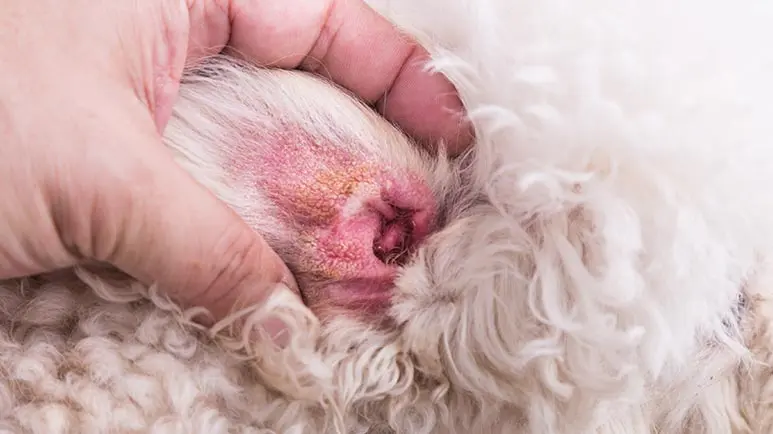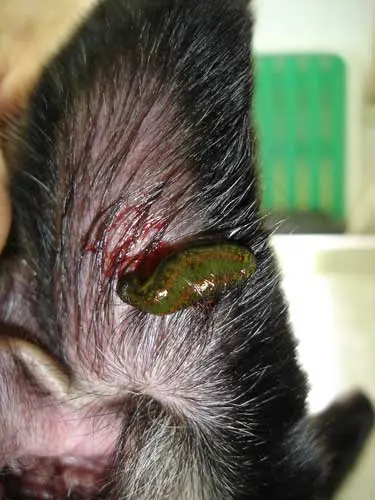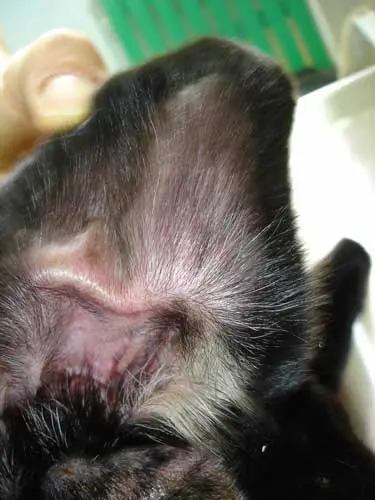Treat Dog Ear Hematoma Promptly or Your Home Could End up Looking Like a Crime Scene
Most vets prefer to treat this common condition with surgery, but years ago, a patient whose owner ignored veterinary advice and insisted against surgery. To her horror, by the next day her home looked like a crime scene and she quickly changed her mind. Don't let it happen to your dog or cat.

STORY AT-A-GLANCE
- Ear hematomas, which are fluid-filled pockets on the inside of the earflap, are a common problem in dogs — especially dogs with long, floppy ears
- Ear hematomas most often develop as the result of aggressive head shaking or scratching at the ears to relieve itching
- Most veterinarians prefer to resolve ear hematomas with surgery because other methods, such as aspiration, are often not as successful
- Medicinal leeching is another approach to treating ear hematomas that is highly effective when performed by a trained professional
- It’s important to also identify and resolve the root cause of ear irritation and head shaking
Editor's Note: This article is a reprint. It was originally published September 11, 2016.
An ear hematoma, also called an aural hematoma, is a fluid-filled pocket on the inside of your dog’s earflap. There are tiny blood vessels in the ears that sometimes rupture, resulting in bleeding under the skin and a little pocket full of blood and pus.
Ear hematomas are most commonly seen in floppy-eared dogs, but they can occur in any breed of dog, and occasionally in cats.
How Dogs Wind up with Ear Hematomas
Most dogs develop ear hematomas from shaking their heads or scratching at their ears as the result of allergies that cause intense itching. An ear infection can also cause your dog to scratch and dig at his ears.
Believe it or not, vigorous head shaking alone can be enough to cause those tiny blood vessels to burst. So can striking the ear against something during head shaking. Other causes of ear hematomas include:
- Injury to the earflap (usually from a dogfight) or some other trauma to the ear
- Inflammation or infection of the ear
- Presence of a foreign body in the ear
- Parasites (e.g., ear mites)
Once bleeding under the skin begins, it creates irritation, which will make your dog shake his head even more. If the problem isn't addressed and blood and other fluids continue to accumulate in the skin, the hematoma can become quite large, even to the point of blocking off the opening of the ear canal.
It's not uncommon for ear hematomas to rupture while the dog is shaking his head, spraying blood all over the place. Hopefully, you won’t let your dog’s ear hematoma get to this point!
Ear hematomas are usually very obvious, so your veterinarian can probably diagnose the problem just by examining your dog’s ears. A swollen, warm, squishy area of the ear usually indicates a small hematoma.
However, a hot, very firm feel can indicate the presence of a large hematoma that affects the entire pinna (floppy part of the ear).
Attempting to Treat Ear Hematomas Without Surgery
There are a few different procedures your veterinarian might use to get rid of an ear hematoma. Most veterinarians resolve the majority of hematomas with surgery; however, most pet parents want to try other approaches first.
One method is aspiration, in which a syringe is inserted to draw out the fluid. Aspiration is a relatively inexpensive and easy procedure to do, but it has some drawbacks. The most frequent consequence is that the empty pocket left by the aspirated fluid fills back up.
Sometimes, multiple aspirations are needed to drain all the fluid out. There's also a risk of introducing an infection into the aspiration site. In addition, if the fluid in the hematoma is clotted and scar tissue is already forming, there may not be much fluid to aspirate.
Years ago, a pet parent whose dog had an ear hematoma refused surgery, and insisted on lancing the dog’s ear. She planned to follow up with herbs to assist in clotting and healing, despite warnings that the hematoma would probably continue to bleed after it was lanced.
The ear looked better after it was pricked because all the fluid drained out, and it went back to its normal size. The owner left happy, but she called the vet the next day to say her dog had been shaking his head non-stop and so much blood had sprayed from the hematoma that her home looked like a crime scene!
Next, she suggested a vent to be inserted in the dog’s ear — an idea she came up with while researching the problem online. While some veterinarians do sew or suture a little vent or cannula in the earflap that allows the fluid to drain over time, it doesn’t fix the blood spray problem because each time the dog shakes his head, blood flies from the little vent in the earflap. The dog’s owner wound up bringing him back the next day for surgery.
Medicinal Leeching to Treat Ear Hematomas
These days, instead of recommending surgery, medical leeching can be done to treat an ear hematoma. There are several veterinary disorders that can be very effectively treated with leeching, and vascular and blood-borne issues like ear hematomas are among them.
Leeching is minimally invasive, and there’s little to no pain involved thanks to an anesthetic substance found in leech saliva. When a leech feeds, it can remove 1 to 2 teaspoons of blood per feeding. The site will continue to ooze an additional 1 to 2 teaspoons for another 24 to 48 hours after the leech falls off or is removed.
As soon as a leech attaches to the treatment area, it begins to release saliva into the wound, which causes the host animal’s blood to become very dilute and fluid, with inhibited coagulation. Shortly afterwards, the leech starts feeding on the host animal’s blood. It sucks mainly venous blood, which resolves congestion.
Meanwhile, the leech’s saliva continues to be released into the wound, providing anticoagulant, anti-inflammatory and antibiotic benefits to the local area. The saliva also has properties that stimulate blood circulation to and from the wound site, and provide analgesic and vasodilator effects as well.
How Leech Therapy Is Performed
First and foremost, leeching should only be performed by someone trained in the procedure. The right environment is also required. It’s important to know that leeches have an aversion to strong odors, so the dog patient shouldn’t smell of scented soaps or have scented ointments applied. Pest repellents are also out, along with essential oils.
Leeches typically suck until they fall off by themselves. Removing a leech prematurely is generally not a good idea, since it can reduce the therapeutic effect.

No wound care is necessary after the leech is finished. In fact, that second hemorrhage of 1 to 2 teaspoons of blood that continues to drain after the leech falls off actually cleans the wound. Once complete, the wound immediately closes and forms a scab.

Animals tolerate leech therapy very well. There’s no reason dogs can’t move around during the treatment. However, they must be closely supervised to prevent them from pawing or rubbing at the treatment area. They should also be prevented from lying down on the ear being treated while the leeches are still attached.
Identifying the Cause of Your Dog’s Ear Hematoma
Treatment of an ear hematoma involves not only resolving the swelling, but also determining what created the problem in the first place. There's usually an underlying cause for ear irritation and head shaking.
It's important that your veterinarian investigates potential underlying issues, and treats the root cause of the hematoma to prevent recurrence. If there's trauma or injury to the earflap, obviously the wound will be treated. But most of the time, the underlying cause is an ear infection or an intense allergic response.
Your pet's ear will be examined with an otoscope and cleaned out. The discharge will be microscopically examined for the presence of bacteria, yeast or mites. Anything that could create an underlying irritation that causes your pet to scratch or shake will be evaluated.
If necessary, a culture will be performed to determine what infection is present, and most importantly, what medications will be needed to help resolve the infection. In some cases, infections can be resistant to all medications and other solutions, such as professionally blended essential oil concoctions, will need to be used.
If the problem is allergies, you'll need to figure out what your pet is allergic to, if possible. This means eliminating the source of the problem, whether it's a dietary issue or an environmental allergic response.
Especially if you have a dog with long floppy ears, it's important to check them regularly and clean them as often as necessary to make sure they stay dry. In particular, you should give them a thorough cleaning and insure they thoroughly dry after swimming and baths, to help prevent an ear hematoma from developing.











